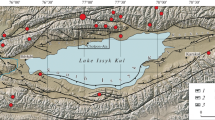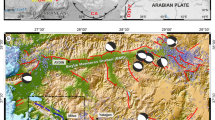Abstract
Northern Thessaly may represent an important seismic gap within the broader Aegean Region, with major faults bordering the ESE–WNW trending Late Pleistocene–Holocene Tyrnavos Basin. In order to obtain information about the characteristics of past earthquakes and improve our knowledge on the seismic potential of the investigated area, historical and archaeological observations are analysed and compared with the results of palaeoseismological trenches excavated across one of the major bordering structures, the Tyrnavos Fault. The former data clearly document (i) a strong seismic activity affecting the area during the last 2–3 ka and (ii) the occurrence of recent earthquakes not included in the seismic catalogues. Also, the sedimentological, structural and chronological data (TL, OSL and AMS) obtained from the palaeoseismological trenches indicate Late Pleistocene to Holocene morphogenic activity of the Tyrnavos Fault, characterised by vertical co-seismic displacements of 20–40 cm and possible return periods of a few thousands of years. Advantages and limitations in using historical and archaeoseismological data are discussed, as well as the problems arising from analysing low slip-rate faults.
Similar content being viewed by others
References
Ambraseys N (1988) Engineering Seismology. J Earthquake Eng Struct Dyn 17:1–105
Ambraseys NN, Finkel CF (1992) The seismicity of the Eastern Mediterranean region during the turn of the 18th century. Izmit 42:323–343
Ambraseys NN, Finkel C (1993) Material for the investigation of the seismicity of the Eastern Mediterranean region during the period 1690–1710. In: Stucchi M (ed.) Historical investigation of European earthquakes, vol 1, pp 173–194
Ambraseys NN, Jackson JA (1990) Seismicity and associated strain of central Greece between 1890 and 1988. Geophys J Int 101:663–708
Caputo R (1990) Geological and structural study of the recent and active brittle deformation of the Neogene-Quaternary basins of Thessaly (Greece), Scientific Annals, vol 12, Aristotle University of Thessaloniki, Thessaloniki
Caputo R (1993a) Morphogenic earthquakes: a proposition. Bull INQUA-Neotectonic Comm 16:24
Caputo R (1993b) Morphotectonics and kinematics along the Tirnavos Fault, northern Larissa Plain, mainland Greece. Zeit fur Geomorph 94:167–185
Caputo R (1993c) The Rodia Fault: an active complex shear zone (Larissa Basin, Central Greece). Bull Geol Soc Greece XXVII:447–456
Caputo R (1994) Late Quaternary faulting in Thessaly, Greece. J Geod Soc Japan, Spec. Issue 397–399
Caputo R (1995) Inference of a seismic gap from geological data: Thessaly (Central Greece) as a case study. Ann Geofisica 38:1–19
Caputo R, Helly B (2000) Archéosismicité de l’égée: étude des failles actives de la Thessalie. Bull Correspondance Hellenique 124(2):560–588
Caputo R, Helly B (2005) Archaeological evidences of past earthquakes: a contribution to the SHA of Thessaly, Central Greece. J Earthquake Eng 9(2):199–222
Caputo R, Pavlides S (1993) Late Cainozoic geodynamic evolution of Thessaly and surroundings (central-northern Greece). Tectonophys 223:339–362
Caputo R, Bravard J-P, Helly B (1994) The Pliocene-Quaternary tecto-sedimentary evolution of the Larissa Plain (Eastern Thessaly, Greece). Geodin Acta 7:57–85
Caputo R, Pellegrini F, Santarato G, Signanini P (1998) L’utilizzo di prospezioni geofisiche nella ricerca paleosismologica, 79° Congr. Soc. Geol. It., Palermo, September 21–23, 1998. Riassunti A:223–224
Caputo R, Pavlides S, Papadopoulos G, Helly B (1999) Palaeoseismological researches in Northern Thessaly, Greece, VII Congress of the European Union of Geosciences, Strasbourg, March 28–April 1, 1999, Abstracts
Caputo R, Piscitelli S, Oliveto A, Rizzo E, Lapenna V (2003) The use of electrical resistivity tomography in Active Tectonic. Examples from the Tyrnavos Basin, Greece. J Geodyn 36(1–2):19–35
Chatzipetros A, Pavlides S, Mountrakis D (1998) Understanding the 13 May 1995 western Macedonia earthquake: a paleoseismological approach. J Geodyn 26:327–339
Guidoboni E, Comastri A, Traina G (1994) Catalogue of ancient earthquakes in the Mediterranean area up to 10th century, ING-SGA, Bologna
Hancock PL, Barka AA (1987) Kinematic indicators on active normal faults in western Turkey. J Struct Geol 9(5/6):573–584
Hatzfeld D, Karakostas V, Ziazia M, Selvaggi G, Leborgne S, Berge C, Guiguet R, Paul A, Voidomatis P, Diagourtas D, Kassaras I, Koutsikos I, Makroulos K, Azzara R, Di Bona M, Baccheschi S, Bernard P, Papaioannou C (1997) The Kozani-Grevenà (Greece) earthquake of 13 May 1995 revisited from a detailed seismological study. Bull Seism Soc Am 87(2):463–473
Helly B (1970) À Larisa: bouleversement et remise en ordre de sanctuaires. Mnemosyne 23:250–296
Helly B (1983) Observations et théories sur les séismes dans les sources historiques grecques. In: Tremblements de terre, histoire et archéologie, Actes des Rencontres Internationales d’Histoire et d’Archéologie d’Antibes, November 2–4, 1983, 63–71
Helly B (1991) Les premiers agriculteurs de la Thessalie: mythe des origines à la lumière de la philologie, de l′archéologie et de la linguistique. In: Rites et rythmes agraires, Séminaire de recherche sous la direction de Marie-Claire Cauvin, TMO 20, Lyon, 135–147
Helly B (2000) La description du Pénée thessalien par Strabon: éléments d′une représentation de l′espace géographique chez les Anciens. In: Bonnafé A, Decourt J-Cl, Helly B (eds.) L′espace et ses représentations. TMO 32, Lyon, pp 25–71
Helly B, Bravard J-P, Caputo R (2000–2002) La Plaine orientale de Thessalie: mobilité des paysages historiques et évolution tecto-sédimentaire, Thessaliko Imerologhio 38 (2000), 3–35; 39 (2001), 73–96; 40 (2001), 145–164; 41 (2002), 165–190 [in Greek]
Koukouvelas IK, Stamatopoulos L, Katsonopoulou D, Pavlides S (2001) A palaeoseismological and geoarchaeological investigation of the Eliki fault, Gulf of Corinth, Greece. J Struct Geol 23(2–3): 531–543
Lucas G (2002) Ena iero tou Ploutona stin pighi Mati? [A sanctuary of Pluton at the Mati spring?], Proc. 4th Congress “Larissa and the history of the region”, April 12–13, 1997, 107–124 [in Greek]
Maravelakis (1939) Beitrag zur Kenntnis der Erdbebengeschichte in Griechenland und den Nachbarländern aus den “Erinnerungen”, Epistimoniki Epetiris Scholis Fysikon kai Mathimatikon Epistimon 5, 69–148 [in Greek with German abstract]
Mercier J-L, Sorel D, Vergely P, Simeakis K (1989) Extensional tectonic regimes in the Aegean basins during the Cenozoic. Basin Res 2:49–71
Papadopoulos GA (1992) Rupture zones of strong earthquakes in the Thessalia region, Central Greece. Proc XXIII Gen Assembly E.S.C. Prague, Sept. 1992. vol 2, pp 337–340
Papadopoulos GA, Kijko A (1991) Maximum likelihood estimation of earthquake hazard parameters in the Aegean area from mixed data. Tectonophys 185:277–294
Papadopoulos GA, Drakatos D, Papanastassiou D, Kalogeras I, Stavrakakis G (2000) Preliminary results about the catastrophic earthquake of 7 September 1999 in Athens, Greece. Seismol Res Lett 71:318–329
Papaioannou I (1984) To protos istorika martyroumenos seismos tis Thessalias [The first historically documented earthquake of Thessaly], Eleftheria Newspaper, February 12, 1984, Larissa [in Greek]
Papaioannou I (1988) I seismiki istoria tis Larisas kata to 18o kai 19o aiona [The seismic history of Larissa during the 18th and 19th centuries], Eleftheria Newspaper, August 7, 1988, Larissa [in Greek]
Papazachos BC, Comninakis PE (1982) A catalogue of historical earthquakes in Greece and surrounding area: 479 BC–1900 AD, Geophys. Lab. Univ. of Thessaloniki Publ 5, pp 1–24
Papazachos BC, Papazachou C (1997) The Earthquakes of Greece. Editions ZITI, Thessaloniki
Pavlides S (1996) First Palaeoseismological Results from Greece. Ann Geofisica 34:545–555
Pavlides S, Caputo R (1997) Field trip to Western Macedonia and Thessaly (Recent and active tectonics in Western Macedonia and Thessaly—the Kozani-Grevena earthquake of 1995), Guide booklet, 29th General Assembly IASPEI, Thessaloniki, August 18–28, 1997
Pavlides S, Caputo R (2004) Magnitude versus faults’ surface parameters: quantitative relationships from the Aegean. Tectonophysics 380(3–4):159–188
Pavlides SB, King GCP (1998) The 1995 Kozani-Grevena earthquake (N. Greece): an introduction. J Geodyn 26(2–4):171–173
Pavlides SB, Zouros NC, Chatzipetros AA, Kostopoulos DS, Mountrakis DM (1995) The 13 May 1995 western Macedonia, Greece (Kozani-Grevena) earthquake; preliminary results. Terra Nova 7:544–549
Poolton NRJ, Robertson GB (1997) Sediment dating by luminescence. Radiat Meas 27:893–922
Shebalin NV, Karnik V, Hadzievski D (eds.) (1974) Catalogue of earthquakes, part II, prior to 1901, UNDP/UNESCO Survey of the seismicity of the Balkan region, Skopje
Spyropoulos PJ (1997) Chronicle of the earthquakes in Greece from the ancient time till now, n.p. [in Greek]
Stewart IS, Hancock PL (1991) Scales of structural heterogeneity within neotectonic normal fault zones in the Aegean region. J Struct Geol 13:191–204
Stucchi M, Albini P, Camassi R, Musson RMW, Tatevossian R (2001) Main results of the Project BEECD “A Basic European Earthquake Catalogue and a Database for the evaluation of long-term seismicity and seismic hazard”. In: Yeroyanni M, Margottini C, Zonno G (eds.) Tools for planning in seismic areas: integrated approaches and data availability, European Commission Volume, Brussels. URL: http://emidius.irrs.mi.cnr.it/BEECD/home.html
Tziafalias A (1994) Dekapente chronia anaskafes stin archaia Larisa [Fifteen years of excavations in ancient Larissa]. In: La Thessalie. Quinze années de recherches archéologiques, 1975–1990, Actes du colloque international, Lyon, April 17–22, 1994, 153–178 [in Greek]
Wolters C (1979) Recherches sur les stèles funéraires hellénistiques de Thessalie, In: La Thessalie, Actes de la table ronde, Lyon, July 21–24, 1975, pp 81–110
Author information
Authors and Affiliations
Corresponding author
Rights and permissions
About this article
Cite this article
Caputo, R., Helly, B., Pavlides, S. et al. Archaeo- and palaeoseismological investigations in Northern Thessaly (Greece): Insights for the seismic potential of the region. Nat Hazards 39, 195–212 (2006). https://doi.org/10.1007/s11069-006-0023-9
Received:
Accepted:
Issue Date:
DOI: https://doi.org/10.1007/s11069-006-0023-9




